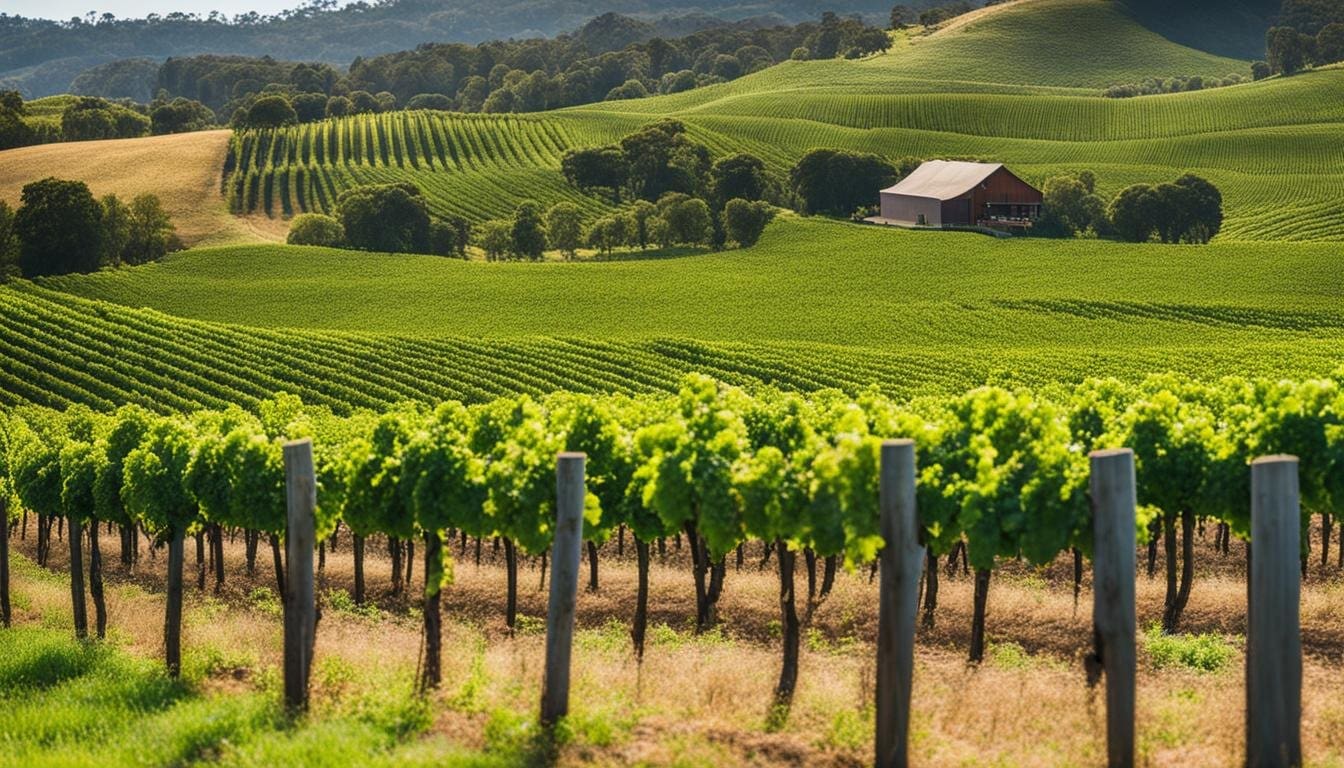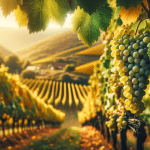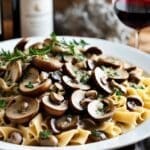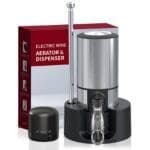This post may contain affiliate links. Please read my disclosure policy.
Join me on a taste journey as we explore the unique qualities of Australian Riesling wines. These versatile and distinctive wines have gained recognition worldwide, and it’s time we unveil the characteristics that set them apart from other Riesling varieties.
Key Takeaways
- Australian Riesling wines showcase rich and diverse taste profiles
- Originating from various regions in Australia, each Riesling wine carries a unique terroir influence
- These wines are suitable for pairing with a wide range of cuisines
- Choosing the right glassware and serving temperature can greatly enhance the tasting experience
- Australian Riesling wines possess the potential to age gracefully and develop additional complexity over time
- Notable wineries in regions like Clare Valley and Eden Valley produce exceptional Riesling wines
- Perfect for various occasions, Australian Riesling is a delight for wine enthusiasts of all kinds
What’s So Special About Australian Riesling?
When it comes to understanding the appeal of Australian Riesling, one must appreciate the unique profile of Riesling grape variety and the influence Australia has on this fruit. As a wine, Riesling has the remarkable ability to convey the character of different terroirs, making it a true reflection of its regional influences.
Unpacking the Unique Profile of Riesling Grape Variety
The transparent nature of the Riesling grape may be attributed to its traditional growth in regions well-suited for its cultivation, such as the Mosel and Rhine valleys of Germany, Austria, and Alsace. Some believe that Riesling is even more adept at transmitting terroir than Pinot Noir and Chardonnay, which are often planted in less suitable locations.
Introduced to Australia by German immigrants in the 19th century, Riesling has since been cultivated with a focus on suitable regions like Clare Valley, Eden Valley, Great Southern, and Tasmania.
These areas are known for producing Rieslings with distinguishable characteristics, notably lime flavours with a touch of floral and earthy mineral notes. Clare Valley Rieslings, in particular, exhibit a floral quality and wet stone aroma, demonstrating how the wine’s profile is shaped by its regional influence on Riesling.
Regional Influence: How Australia Makes its Mark on Riesling
The growing regions of Riesling are key to understanding the distinctive qualities of Australian Riesling. To better appreciate this, let’s delve into some examples:
- Clare Valley – Known for producing Rieslings with a lime-citrus profile and a floral, wet stone aroma.
- Eden Valley – Produces Rieslings with bright acidity, green apple flavours, and fine minerality.
- Great Southern – Rieslings from this region often display vibrant acidity, intense fruit flavours, and pronounced minerality.
- Tasmania – Cool climate Rieslings from this island state tend to have high natural acidity and intense citrus flavours.
As seen from these examples, the Australian impact on Riesling is evident in the diversity of flavours and characteristics displayed across the different growing regions. This uniqueness is what draws connoisseurs of Riesling to Australian shores, as they are drawn to immerse themselves in the delightful variety and unparalleled regional expressions.
Riesling Down Under: Taste Characteristics Unique to Australia
While it can be challenging to generalize the taste profile of Riesling due to the diverse range of flavours and regional influences, some taste characteristics of Riesling are unique to Australia. The country’s Rieslings commonly feature lime, with Clare Valley Rieslings also expressing floral attributes. In addition to these flavours, many Australian Rieslings possess earthy mineral notes, such as a wet stone aroma.
The quality of Australian Rieslings can vary, with some exhibiting intrigue and superb balance, while others may fall short. The individual taste characteristics of each Riesling depend largely on the regional influence and the skills of the winemakers, who strive for the perfect balance between fruit, acidity, and minerality in their wines.
To better understand the unique taste characteristics of Australian Riesling, we can explore some of the most prominent growing regions:
- Clare Valley Rieslings are known for their lime and floral qualities, reflecting the region’s distinctive terroir.
- Eden Valley Rieslings offer a softer, more textured palate with stone fruit flavours, complemented by the region’s cooler climate and higher altitude.
- Great Southern Rieslings showcase bright acidity and minerality, thanks to the region’s cool coastal influence.
- Tasmanian Rieslings, with their pristine island environment, often introduce vibrant citrus and green apple notes, enhanced by a crisp acidity.
Each of these regions contributes to the Australian Riesling uniqueness, providing wine lovers with a diverse array of taste profiles to enjoy.
| Region | Taste Characteristics |
|---|---|
| Clare Valley | Lime, floral, wet stone aroma |
| Eden Valley | Stone fruit, textured palate |
| Great Southern | Bright acidity, minerality |
| Tasmania | Citrus, green apple, crisp acidity |
In summary, the uniqueness of Australian Riesling comes from its regional diversity, resulting in a beautiful array of taste characteristics, ranging from lime and floral attributes to brighter fruit flavours and pronounced minerality. It is this variety that makes Australian Riesling an exciting and enjoyable wine for enthusiasts around the world.
Australian Riesling and the Senses: Flavour Notes Explored
As you embark on your tasting journey through Australian Riesling, you will discover an intricate world of delightful flavours, enticing aromas, and complex layers. This diverse range of sensations can make each sip a unique adventure. Let’s dive deeper into deciphering these flavour notes and understanding the primary flavours that define Australian Riesling.
Deciphering the Primary Flavours of Australian Riesling
The primary flavours of Australian Riesling can be quite diverse. However, there are some keynotes that are often present in these exquisite wines. Some examples of primary flavours you may encounter when tasting an Australian Riesling include:
- Lime
- Petrol
- White flowers
- Tropical fruits
These primary flavours can vary in intensity and combination, and may even be accompanied by additional notes like honey or apricot. This complex interplay of flavours is part of what makes the tasting experience of Riesling so engaging and delightful.
Some expressions of these Rieslings, such as the 2015 Clare Valley Riesling from Some Young Punks labelled “Monsters, Monsters, Attack!”, even reflect a sweetness similar to a German Spätlese, balanced with apricot and mineral flavours, pointing to the variety and complexity of flavour notes these wines can offer.
As you immerse yourself in the tasting journey, Australian Riesling will unveil an ever-evolving landscape of flavours and notes that shape your sensory experience. Ultimately, understanding these primary flavours of Riesling will enhance your overall journey and appreciation of this remarkable wine.
Understanding the Soil: The Terroir of Australian Riesling
The soil conditions for Riesling play a crucial role in shaping the wine’s character, with the terroir of Australian Riesling contributing to distinct taste profiles and regional differences. For instance, the soils in Clare Valley and Eden Valley create unique characteristics that are prevalent in Rieslings from these areas, such as earthy, wet stone qualities.
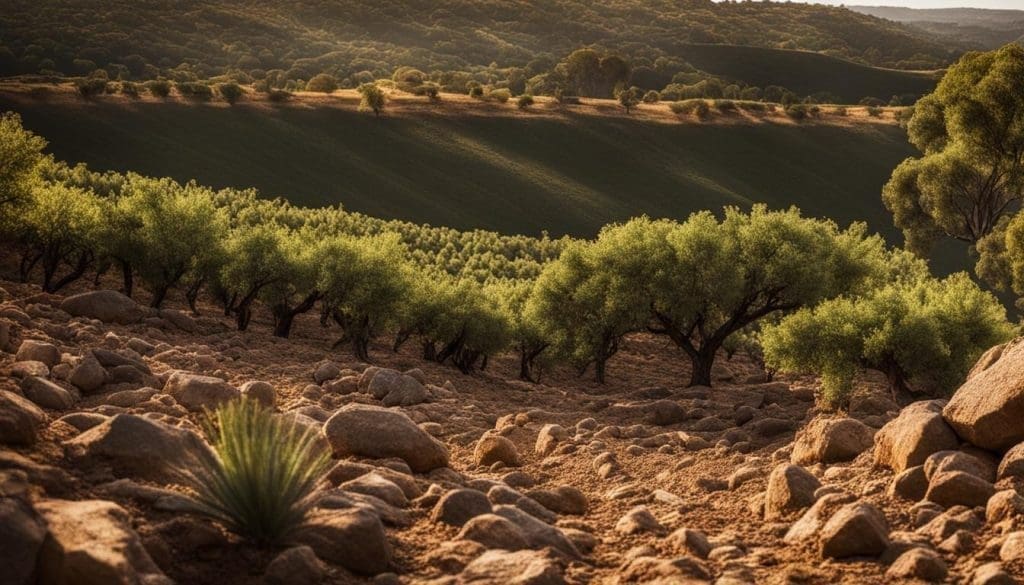
Let’s take a deeper dive into the soil types and their influence on Australian Riesling:
- Clare Valley: The soils in this region are predominantly red clay, slate, and limestone. These soil types lend a minerality and flintiness to the wines, adding depth and complexity to the taste of Clare Valley Rieslings.
- Eden Valley: Eden Valley soils are characterised by shallow, rocky, and sandy loam. This composition enables vine roots to reach for moisture and nutrients deep in the ground, resulting in wines with crisp acidity and delicate floral notes.
- Great Southern: The soils here consist mainly of granitic soils and gravelly loam, which contribute to the wines’ distinct mineral qualities and precise, citrusy flavours.
- Tasmania: This island state boasts soils rich in volcanic basalt, which lend an aromatic intensity and vibrant natural acidity to the Rieslings produced here.
“The soil is the chalkboard on which the vines leave their mark.” – Louis Albert Pétrus Panisset
Soil conditions for Riesling not only influence flavour and aromatics, but also the grapevines’ growth habits and overall health. Vines grown in nutrient-rich soils can lead to overly-vigorous growth, resulting in less concentrated flavours, while vines grown in nutrient-deficient soils can struggle to produce a healthy crop. It is this delicate balance of soil composition and vine health that winemakers strive to achieve, helping them craft the perfect Australian Riesling that reflects the diverse and expressive nature of the terroir.
Climate’s Role in Crafting the Perfect Australian Riesling
The terrestrial conditions of a vineyard, specifically the climate, play a significant role in the development of a Riesling grape. Factors such as temperature and sun exposure have a direct impact on the flavours and aromas that make up a particular wine. In this section, we delve into the significance of climate in cultivating the perfect Australian Riesling and how temperature and sun exposure can make or break a wine’s character.
Why Temperature and Sun Exposure Matter for Riesling
As a grape variety native to cooler climates, Riesling grapes thrive in environments with lower average temperatures. The exquisite flavour profiles and aromatics of Australian Riesling can be attributed to the unique climate for Riesling found in regions such as the Clare and Eden Valleys. Let’s explore the role of temperature and sun exposure in the development of these grapes.
- Temperature: Cool climates contribute to the slow and steady ripening process of Riesling grapes, leading to a heightened concentration of natural flavours and fragrances. Alongside this, the ideal temperature impact on Riesling allows the grapes to retain bright acidity and develop lower alcohol levels, elevating the wine’s quality and distinction.
- Sun exposure: Similar to temperature, optimal sun exposure for Riesling grapes is imperative for creating well-rounded and intricate expressions of this varietal. In cooler regions, the grapes receive a longer period of sunlight exposure, as the ripening process is extended due to the lower temperatures. This prolonged basking in the sun allows Riesling grapes to develop a more refined balance of acidity, sweetness and complexity.
To summarise, the perfect Australian Riesling owes its alluring characteristics to the ideal blend of cool temperatures and sufficient sunlight found in regions like the Clare and Eden Valleys. These factors allow Riesling grapes to fully express their unique flavour profiles and create truly memorable Australian wines.
History in a Bottle: The Evolution of Australian Riesling
The history of Riesling in Australia dates back to the 19th century, when German immigrants first introduced the grape variety to the continent. Since then, Australia has witnessed a significant evolution of the Riesling grape and its role in the wine industry. What was once a focus on bulk wine production has now transformed into an emphasis on quality and true expression of terroir.
German immigrants initially planted Riesling in Australia in the 19th century, and over time, the focus shifted from bulk to quality wine production.
Two notable regions leading the charge in Australian Riesling production are the Clare Valley and the Eden Valley. Both have successfully nurtured the grape variety, allowing it to evolve and produce wines that reflect the unique characteristics of their respective terroirs.
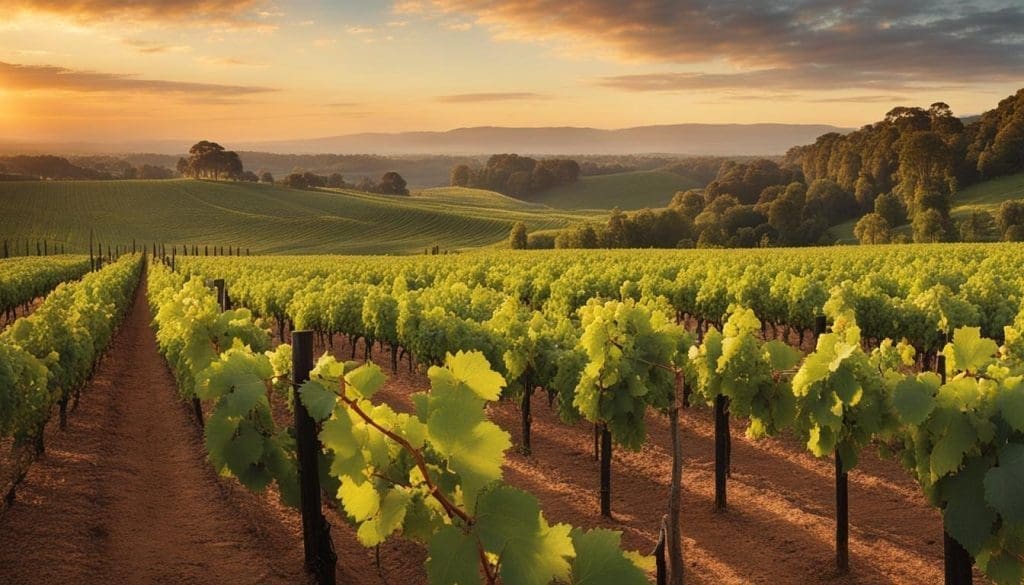
The background of the Riesling grape reveals its adaptability, enabling winemakers to successfully grow it in numerous locations and soil types. This versatility has allowed Australia to develop diverse and distinctive Riesling wines, contributing to the country’s reputation for producing exceptional examples of this elegant and complex grape.
- Clare Valley: Known for its lime and floral qualities, with a signature wet stone aroma.
- Eden Valley: Famed for producing Rieslings with higher acidity, giving the wine a structure well-suited for ageing.
Over the years, winemakers and viticulturists in Australia have adapted to better understand the needs of the Riesling grape, resulting in improved techniques and practices that have elevated the quality and reputation of Australian Riesling.
In summary, the evolution of Riesling grape in Australia serves as a testament to the dedication and innovation of the country’s winemakers and their pursuit of excellence in crafting Riesling wines that stand tall among the best in the world.
A Guide to Serving Australian Riesling: Temperature and Glassware
Enrich your Riesling tasting experience by mastering the art of serving temperature and glassware selection. Proper serving temperature enhances the wine’s flavour and aroma, while the right glassware can greatly elevate its sensory presentation.
Perfect Serving Temperature in Celsius and Fahrenheit
The ideal serving temperature for Riesling is a crucial factor in allowing the wine to reveal its true potential. You should serve Riesling slightly chilled, with the recommended temperature lying between 8-11°C (46-52°F). Serving the wine at this temperature range ensures that its flavours and aromas truly shine.
| Wine Type | Ideal Temperature in Celsius | Ideal Temperature in Fahrenheit |
|---|---|---|
| Australian Riesling | 8-11°C | 46-52°F |
| German Riesling | 8-10°C | 46-50°F |
| French Riesling | 9-11°C | 48-52°F |
The Impact of Glassware on Your Riesling Tasting Experience
Choosing the proper glassware is another essential aspect of enjoying Riesling to the fullest. A good glass will enhance the wine’s aromatic profile and overall sensory enjoyment. The recommended glass type for Riesling is a tulip-shaped glass with a moderate bowl size and a slight taper towards the top. This design captures and focuses the delicate aromas of Riesling while allowing enough space for swirling and aerating the wine.
“The right glassware is vital in revealing the subtle nuances that make Riesling such a special wine variety. Invest in quality Riesling glasses, and you’ll experience a noticeable difference in your wine enjoyment.”
Raising your wine game with the perfect serving temperature and appropriate glassware will allow Riesling, and other wine varieties, to shine. By following these guidelines, you’ll elevate your wine-tasting experience and impress friends and family at your next gathering.
The Art of Pairing: Best Cuisine Matches for Australian Riesling
Australian Riesling, with its diverse flavour profiles, pairs exceptionally well with a variety of cuisines. The lime aspect of Clare Valley Rieslings, for instance, makes it an excellent match for oysters, reinforcing the versatility of these wines in gastronomy.
Aside from oysters, there are numerous other dishes that make a perfect cuisine match for Riesling. To help you find the perfect wine and food pairing for Riesling, here are some suggestions that complement the flavours and aromas of Australian Riesling wines:
These food pairings are just a starting point, and with the range of flavour profiles found in Australian Riesling wines, there is plenty of room for experimentation. So, don’t be afraid to get creative and explore new food pairings with Riesling to discover your personal favourites.
| Suggested Food Pairings | |
|---|---|
| Food | Notes |
| Thai Green Curry | The spicy heat of a Thai green curry is nicely balanced by the citrus notes and minerality found in a Clare Valley Riesling. |
| Fresh Summer Salads | A crisp and refreshing Riesling complements the light and zesty flavours in fresh summer salads. |
| Pork Belly | The natural acidity in Riesling cuts through the rich fattiness of pork belly, making for a balanced and enjoyable pairing. |
| Grilled Snapper | The light and delicate flavours of grilled snapper are well-matched with the citrus and floral notes found in many Australian Rieslings. |
| Mature Cheese | Strong, mature cheeses provide a delicious flavour contrast, highlighting the fruity and floral aspects of Riesling wines. |
Ageing Gracefully: The Potential of Australian Riesling Over Time
Young Australian Rieslings can be very enjoyable to drink, offering lively, tangy flavours that delight the palate. However, they also have the potential to age remarkably well, evolving in complexity and revealing deeper aromas and flavours over time. But should you drink your Riesling now, or wait and enjoy the benefits of ageing?
Should You Drink Riesling Now or Age It?
Deciding whether to drink Riesling now or age it ultimately boils down to personal taste preferences and the expression one seeks to enjoy. Some wine enthusiasts appreciate the vibrant, zesty characteristics of a young Riesling, while others prefer the layered complexities that come with ageing.
The following table compares some common characteristics of young and aged Riesling wines:
| Young Riesling | Aged Riesling |
|---|---|
| Lively, tangy flavours | Complex, evolved flavours |
| Primarily citrus notes (lime, lemon) | Petroleum notes and mature fruit characteristics may emerge |
| Fresh and zesty | Richer, deeper textures |
In addition to personal preferences, the ageing impact on Riesling will depend on the specific wine and its quality. Some Australian Rieslings will mature beautifully, while others may be best enjoyed when they are young and vibrant.
“Some wines are meant to be enjoyed within a few years of release, while others have the structure and balance to develop in the bottle for decades.”
The ageing of Riesling can also be influenced by the wine’s region of origin. For example, the Rieslings from Clare Valley often have exceptional ageing potential due to their natural acidity and well-balanced structure.
- Consider the vineyard and vintage: High-quality Rieslings from reputable vineyards are generally more likely to age gracefully.
- Store Rieslings properly: To ensure your Riesling ages well, store it in a cool, dark place with consistent temperatures and minimal vibrations.
- Be patient: The rewards of ageing Riesling can be truly extraordinary. If you’re unsure, consider cellaring a few bottles to experience the wine’s evolution over time.
Ultimately, the decision to drink Riesling now or age it is up to you. Regardless of your choice, a well-crafted Australian Riesling can provide a wonderful tasting experience that showcases the region’s unique terroir and the grape’s adaptability.
Discovering Australia’s Riesling Regions: From Clare Valley to Tasmania
Exploring the rich offerings of Australian Riesling is an exciting adventure, with the opportunity to dive deep into diverse regions that showcase the best of this beloved grape variety. From the renowned Clare Valley to the picturesque Eden Valley, let us embark on a journey to discover the most notable wineries for Riesling in these exquisite regions.

Spotlight on the Notable Wineries for Australian Riesling
- Clare Valley
Recognised for producing some of the world’s finest Rieslings, the Clare Valley boasts several celebrated wineries that have made a significant impact on the global perception of Australian Riesling. One such winery is Grosset, which has garnered international acclaim for its exquisite Polish Hill Riesling. This wine exhibits exceptional balance and elegance, with stunning flavours reflecting the unique terroir of the region.
- Eden Valley
Another region offering exceptional Riesling experiences is the Eden Valley, celebrated for its high-quality wine production. The pioneering winery Pewsey Vale stands out with a reputation for consistent quality and value, showcasing the quintessential characteristics of Eden Valley Riesling.
- Western Australia
Not to be overlooked is Western Australia’s dedication to the Riesling grape, demonstrated by incredible wineries such as Frankland Estate. Located in the state’s Great Southern wine region, this winery reflects the diversity of locations capable of producing outstanding Riesling in Australia.
| Region | Notable Winery | Acclaimed Wine |
|---|---|---|
| Clare Valley | Grosset | Polish Hill Riesling |
| Eden Valley | Pewsey Vale | Eden Valley Riesling |
| Western Australia | Frankland Estate | Isolation Ridge Riesling |
In conclusion, the vast range of riesling regions in Australia offers limitless possibilities to embark on a taste journey that spans from Clare Valley to Tasmania, and beyond. By experiencing the splendid wines of these prominent wineries such as Grosset, Pewsey Vale, and Frankland Estate, Australian Riesling lovers can gain a deeper appreciation for the diverse expressions of this illustrious grape variety.
The Perfect Occasion for an Australian Riesling
Australian Riesling is a versatile and delightful wine, suitable for various occasions, ranging from casual get-togethers to more formal events. It showcases the unique qualities and characteristics of its region, earning recognition for its outstanding flavours and ability to complement a wide range of dishes.
“Australian Riesling is a celebration of distinctiveness and versatility, a wine that will enhance any event or meal.”
As a summary of riesling, the unique aspects of riesling from Australia include its ability to express the terroir, regional influence, and diverse flavour profiles. Riesling from Australia has garnered recognition for these qualities, making it a wine that every enthusiast should explore. Let’s take a look at some occasions where Australian Riesling will be the perfect choice:
- Casual Gatherings: Australian Riesling’s refreshing and balanced characteristics make it a wonderful option for laid-back get-togethers with friends or family.
- Outdoor Events: The crisp acidity and vibrant character of Australian Riesling make it an ideal companion for outdoor picnics or barbecues.
- Seafood Dinners: As a wine that pairs exceptionally well with seafood, Australian Riesling complements dishes such as oysters, sushi, or grilled fish.
- Holiday Meals: With its diverse flavour profiles, Australian Riesling can accompany a variety of festive dishes, enhancing a holiday meal experience.
- Formal Dining: For special occasions, Australian Riesling can elevate a fine dining experience, enriching the palate with its multifaceted expression.
Ultimately, Australian Riesling is a versatile and adaptable wine that adds a touch of elegance and distinctiveness to any occasion, satisfying both novice and experienced wine enthusiasts alike.
Conclusion
As we’ve explored throughout this article, Australian Riesling presents a truly captivating and delightful experience for wine enthusiasts. With its diverse taste profiles, exceptional ability to express terroir, and impressive ageing potential, it is no wonder that these wines have gained the admiration and attention of critics and consumers alike.
The world of Australian Riesling offers an incredible journey through the country’s rich winemaking heritage and unique regions, from Clare Valley to Eden Valley, Great Southern and Tasmania. The wines produced in these areas showcase the best of what Australian Riesling has to offer, with a striking combination of vibrant flavours, delicate aromas, and outstanding quality.
In summary, Australian Riesling invites us to embark on a delightful and immersive taste journey that continues to evolve and push the boundaries of what’s possible in the world of wine. It is truly one of Australia’s most cherished and treasured wines, reflecting the passion, dedication, and expertise of the country’s winemakers and leaving wine lovers eagerly anticipating their next Riesling encounter.
FAQ
What are the primary flavours of Australian Riesling?
The primary flavours of Australian Riesling can range from lime, petrol, white flowers to, occasionally, tropical flavours. Regional characteristics can also play a role in the unique flavour profiles of Australian Riesling wines.
How do Australian soil conditions affect the taste profile of Riesling?
The soil in which Australian Riesling is grown plays a critical role in the wine’s character, contributing to distinct taste profiles based on the region. For example, the soils of Clare Valley and Eden Valley contribute to the earthy, wet stone characteristics often found in Riesling from these areas.
Why is climate important for Australian Riesling?
The cool climate, particularly in regions like Clare and Eden Valleys, allows for extended ripening, resulting in higher flavour concentration, bright natural acids, and lower alcohol levels, all contributing to the quality and distinctiveness of Australian Riesling.
What is the ideal serving temperature for Australian Riesling in Celsius and Fahrenheit?
The ideal serving temperature for Australian Riesling ranges between 6-10°C (43-50°F), depending on its age, flavours, and personal preference.
Which type of glassware should I use for Riesling?
Choosing the proper glassware can significantly enhance the Riesling tasting experience. A tulip-shaped wine glass is recommended as it helps concentrate the wine’s aromatic profile and overall sensory enjoyment.
What type of cuisine pairs best with Australian Riesling?
Australian Riesling pairs exceptionally well with a variety of cuisines, such as seafood, spicy Asian dishes, and poultry. The specific flavours in a Riesling wine can help determine the best food pairing for each individual bottle.
Can Australian Riesling age well, and should I drink it now or wait?
While young Australian Rieslings can be lively and tangy, they also possess potential to age well, developing additional complexity over time. This decision can be based on personal taste preferences and the expression one seeks to enjoy.
What are some famous Australian wineries known for exceptional Riesling?
Some notable wineries for Australian Riesling include Grosset (known for Polish Hill Riesling) in Clare Valley, Pewsey Vale in Eden Valley, and Frankland Estate in Western Australia.
Source Links
- https://www.nytimes.com/2017/06/08/dining/wine-review-australian-riesling.html
- https://www.jamessuckling.com/wine-tasting-reports/new-era-australian-riesling-flavor-drinkability/
- https://beinspired.au/top5/top-5-australian-riesling/
Sip smarter, subscribe now!
Subscribe for gourmet tips, event updates, travel ideas, and a free e-book on Food Pairings. Start your journey to culinary and travel excellence!
